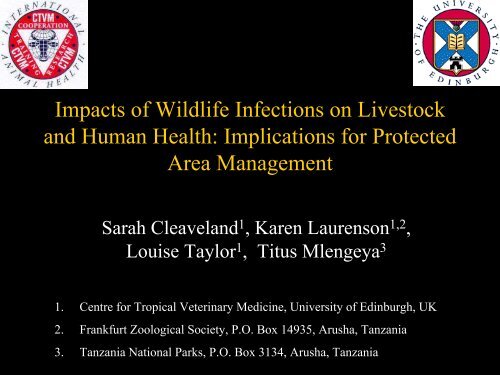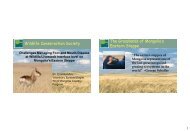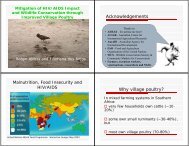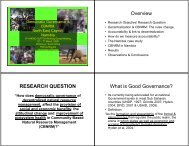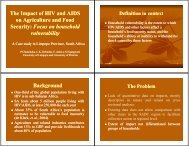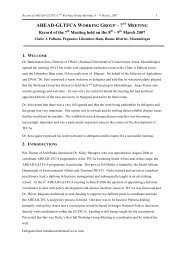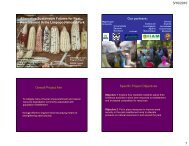PDF of slides - Animal & Human Health for the Environment and ...
PDF of slides - Animal & Human Health for the Environment and ...
PDF of slides - Animal & Human Health for the Environment and ...
You also want an ePaper? Increase the reach of your titles
YUMPU automatically turns print PDFs into web optimized ePapers that Google loves.
Impacts <strong>of</strong> Wildlife Infections on Livestock<br />
<strong>and</strong> <strong>Human</strong> <strong>Health</strong>: Implications <strong>for</strong> Protected<br />
Area Management<br />
Sarah Cleavel<strong>and</strong> 1 , Karen Laurenson 1,2 ,<br />
Louise Taylor 1 , Titus Mlengeya 3<br />
1. Centre <strong>for</strong> Tropical Veterinary Medicine, University <strong>of</strong> Edinburgh, UK<br />
2. Frankfurt Zoological Society, P.O. Box 14935, Arusha, Tanzania<br />
3. Tanzania National Parks, P.O. Box 3134, Arusha, Tanzania
Disease transmission between populations<br />
Zoonoses<br />
HUMAN<br />
DOMESTIC<br />
ANIMAL<br />
WILDLIFE<br />
Threats to<br />
wildlife<br />
Threats to<br />
livestock<br />
economies<br />
L<strong>and</strong>-use conflict<br />
Exacerbating rural<br />
proverty<br />
dem<strong>and</strong> <strong>for</strong> cultivation<br />
dem<strong>and</strong> <strong>for</strong> bushmeat
Direct <strong>and</strong> indirect<br />
impacts <strong>of</strong> MCF<br />
↑ cattle mortality<br />
↓ cattle fecundity<br />
Increase in <strong>the</strong><br />
human population<br />
Reduced herd size<br />
↑ need to sell animal to raise / earn<br />
cash income<br />
↓ livestock : human<br />
ratio<br />
Inability to meet food <strong>and</strong> subsistence needs<br />
=>Increased dem<strong>and</strong> <strong>for</strong> cultivation<br />
=> L<strong>and</strong>-use practices incompatible with traditional<br />
livestock-keeping <strong>and</strong> wildlife conservation
Wildlife <strong>and</strong> Public <strong>Health</strong><br />
• Most (62%) human pathogens are zoonoses<br />
• Almost half (44%) <strong>of</strong> all human pathogens<br />
can infect wildlife<br />
• If a pathogen can infect wildlife it is more<br />
than twice as likely to cause an emerging<br />
human disease than infections that do not<br />
affect wildlife
Factors in Disease Emergence<br />
• Ecological factors<br />
– <strong>Human</strong> demography <strong>and</strong> activities<br />
– Industrialization, de<strong>for</strong>estation, agriculture<br />
– Global human <strong>and</strong> animal movements<br />
– Climate change<br />
• Individual host factors<br />
– E.g. immunosuppression, co-infections (e.g<br />
(HIV)<br />
• Pathogen factors (e.g. mutation,<br />
recombination, genetic drift)<br />
– Evolution <strong>of</strong> new virulent strains<br />
– Evolution <strong>of</strong> drug resistance
Why are wildlife hosts important?<br />
• Wildlife species represent an important ‘zoonotic<br />
pool’ <strong>for</strong> emergence<br />
– => New appearance in human population e.g. HIV-1,<br />
HIV-2, SARS<br />
• Strain mutations combined with increased human-to-human<br />
transmission<br />
– => Increasing incidence <strong>of</strong> older diseases e.g. West<br />
Nile Virus, Ebola, Lyme Disease, Hantavirus infections<br />
– Increasing incidence as a result <strong>of</strong> changing<br />
contact/transmission patterns
• Paramyxovirus<br />
– Cause <strong>of</strong> fatal disease in pigs <strong>and</strong><br />
humans<br />
• Destruction <strong>of</strong> natural habitat<br />
<strong>for</strong> fruit bats?<br />
– De<strong>for</strong>estation<br />
– Intensification <strong>of</strong> pig industry<br />
• Fruit bat (Flying fox - Pteropus<br />
spp) reservoirs<br />
– also Hendra, Menangle, ABL<br />
virus<br />
• Pathogens infecting bats a<br />
group <strong>of</strong> particular concern in<br />
emerging human diseases<br />
Nipah virus
• Filovirus, haemorrhagic<br />
disease<br />
– Concern <strong>for</strong> both human<br />
health <strong>and</strong> wildlife<br />
conservation<br />
• Increasing humanwildlife<br />
contact<br />
– Bushmeat hunting<br />
– De<strong>for</strong>estation,<br />
encroachment?<br />
• Identity <strong>of</strong> animal<br />
reservoir?<br />
Ebola virus
• Central <strong>and</strong> west Africa,<br />
recent cases in north<br />
America<br />
• Contact with infected<br />
animals<br />
– Bushmeat consumption,<br />
h<strong>and</strong>ling prairie dogs<br />
– Also human-to-human<br />
transmission<br />
• Emergence factors:<br />
decline in smallpox<br />
vaccination coverage, pet<br />
trade<br />
Monkey pox
• Factors – genetic changes,<br />
human movement/contact<br />
patterns<br />
• Emergence from wildlife<br />
host?<br />
SARS
Implications <strong>for</strong> Wildlife<br />
Management<br />
• Options <strong>for</strong> disease control<br />
limited<br />
• Many involve harm to wildlife<br />
populations e.g. culling, separation<br />
• Little known about dynamics <strong>of</strong><br />
wildlife infections => decisions about<br />
control with incomplete knowledge<br />
• Investigation <strong>of</strong> diseases<br />
– Identification <strong>of</strong> reservoirs <strong>of</strong>ten<br />
very difficult<br />
– Invasive or lethal sampling,<br />
disruption to populations<br />
• E.g. Search <strong>for</strong> reservoirs <strong>of</strong> Ebola,<br />
monkey pox
Indirect Impacts<br />
• Perception <strong>of</strong> wildlife as health risk <strong>for</strong><br />
humans<br />
– Potential impact on tourism vs need <strong>for</strong><br />
dissemination <strong>of</strong> data <strong>of</strong> public health value<br />
• How much do we need to know?<br />
– <strong>Human</strong> health implications <strong>for</strong><br />
sustainable/consumptive use programmes
Summary<br />
• Need <strong>for</strong> interaction between wildlife<br />
managers/ecologists, veterinarians <strong>and</strong> public<br />
health sector<br />
• Development <strong>of</strong> wildlife policies to address issues<br />
relating to public health<br />
• Epidemiological questions<br />
– Identification <strong>of</strong> reservoir hosts/sources <strong>of</strong> infection<br />
– Design <strong>of</strong> optimum control strategies<br />
– Interpretation <strong>of</strong> increasingly sensitive diagnostic tests


